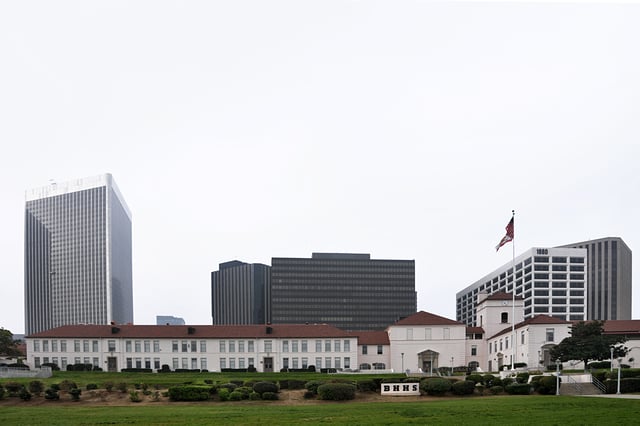Beverly Hills, California
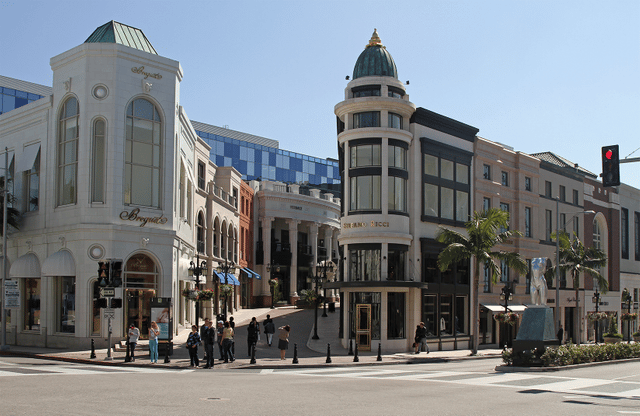
Beverly Hills, California

Beverly Hills, California | |
|---|---|
City | |
| City of Beverly Hills | |
| Nicknames: "Garden Spot of the World", "B.H.", "Bev Hills", "90210", “The Hills” | |
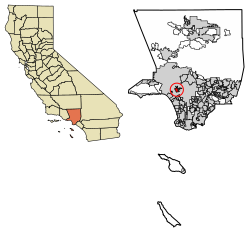 Location within Los Angeles County, California. | |
 Aerial view, 3D computer generated image | |
| Coordinates:34°4′23″N 118°23′58″W [137] | |
| Country | |
| State | |
| County | |
| Incorporated | January 28, 1914[1] |
| Named for | Beverly Farms |
| Government | |
| • Type | Council-manager |
| • Mayor | John A. Mirisch (R) [2][2] |
| • Vice mayor | Lester Friedman [2] |
| • City council | Lili Bosse[2] Robert Wunderlich (D)[3][2] Julian A. Gold, MD |
| • City Manager | George Chavez[4] |
| Area | |
| • Total | 5.71 sq mi (14.79 km2) |
| • Land | 5.71 sq mi (14.78 km2) |
| • Water | 0.00 sq mi (0.01 km2) 0.04% |
| Elevation | 259 ft (79 m) |
| Population | |
| • Total | 34,109 |
| • Estimate (2018)[8] | 34,183 |
| • Density | 6,039.23/sq mi (2,333.15/km2) |
| Time zone | UTC−8 (Pacific) |
| • Summer (DST) | UTC−7 (PDT) |
| ZIP codes | 90209–90213[9] |
| Area codes | 310/424, 323 |
| FIPS code | 06-06308 [138] |
| GNIS feature IDs | 1652672 [139] , 2409840 [140] |
| Website | www.beverlyhills.org [141] |
Beverly Hills is a city in Los Angeles County, California. Located within 5.7 square miles and surrounded by the cities of Los Angeles and West Hollywood, it had a population of 34,109 at the 2010 census[10] and an estimated population of 34,183 in 2018.[8]
Sometimes referred to as "90210", one of its primary ZIP codes, the city is home to many celebrities, luxury hotels, and the Rodeo Drive shopping district.
Originally a Spanish ranch where lima beans were grown, Beverly Hills was incorporated in 1914 by a group of investors who had failed to find oil, but found water instead and eventually decided to develop it into a town.
Beverly Hills, California | |
|---|---|
City | |
| City of Beverly Hills | |
| Nicknames: "Garden Spot of the World", "B.H.", "Bev Hills", "90210", “The Hills” | |
 Location within Los Angeles County, California. | |
 Aerial view, 3D computer generated image | |
| Coordinates:34°4′23″N 118°23′58″W [137] | |
| Country | |
| State | |
| County | |
| Incorporated | January 28, 1914[1] |
| Named for | Beverly Farms |
| Government | |
| • Type | Council-manager |
| • Mayor | John A. Mirisch (R) [2][2] |
| • Vice mayor | Lester Friedman [2] |
| • City council | Lili Bosse[2] Robert Wunderlich (D)[3][2] Julian A. Gold, MD |
| • City Manager | George Chavez[4] |
| Area | |
| • Total | 5.71 sq mi (14.79 km2) |
| • Land | 5.71 sq mi (14.78 km2) |
| • Water | 0.00 sq mi (0.01 km2) 0.04% |
| Elevation | 259 ft (79 m) |
| Population | |
| • Total | 34,109 |
| • Estimate (2018)[8] | 34,183 |
| • Density | 6,039.23/sq mi (2,333.15/km2) |
| Time zone | UTC−8 (Pacific) |
| • Summer (DST) | UTC−7 (PDT) |
| ZIP codes | 90209–90213[9] |
| Area codes | 310/424, 323 |
| FIPS code | 06-06308 [138] |
| GNIS feature IDs | 1652672 [139] , 2409840 [140] |
| Website | www.beverlyhills.org [141] |
History
Early history

Beverly Hills Aerial view in 1919
Gaspar de Portolá arrived in the area that would later become Beverly Hills on August 3, 1769, travelling along native trails which followed the present-day route of Wilshire Boulevard.
The area was settled by Maria Rita Quinteros de Valdez and her husband in 1828.[11] They called their 4,500 acres (18 km2) of property the Rancho Rodeo de las Aguas.[12] In 1854, she sold the ranch to Benjamin Davis Wilson (1811–1878) and Henry Hancock (1822–1883).[11] By the 1880s, the ranch had been subdivided into parcels of 75 acres (0.30 km2) and was being rapidly bought up by anglos from Los Angeles and the East coast.[12]
20th century
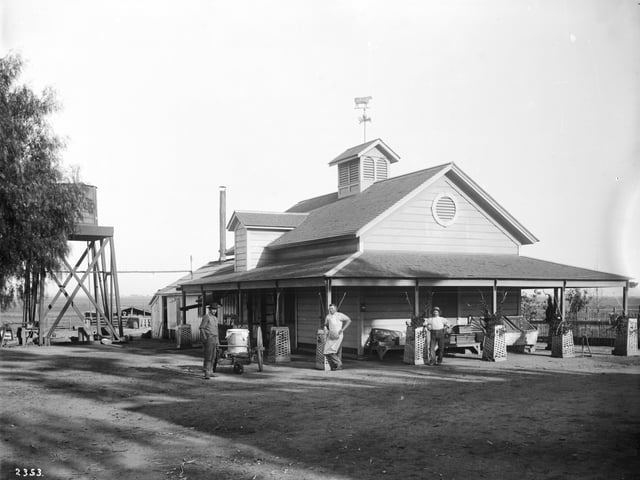
Hammel and Denker ranch, c. 1905
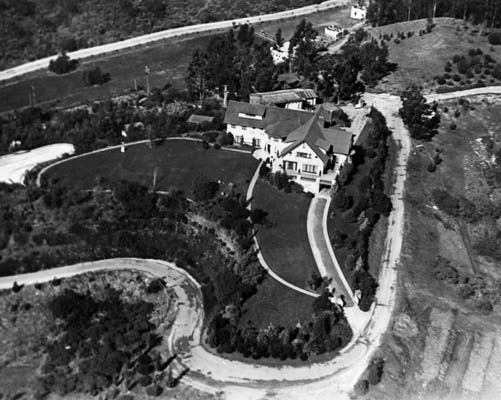
Aerial view of Pickfair, 1920
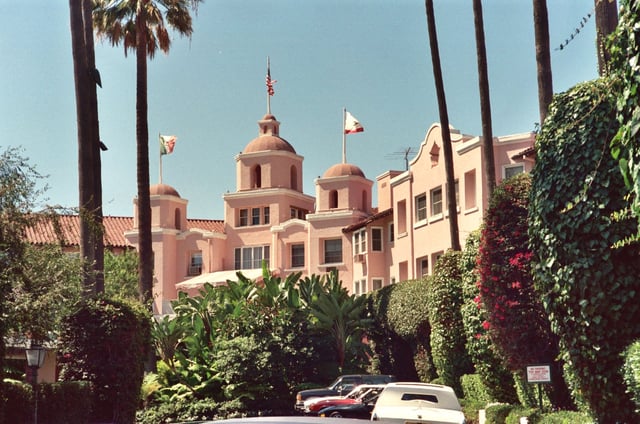
The Beverly Hills Hotel (here in 1989) was the first substantial building project in what developed into Beverly Hills.
In 1900, Burton E. Green, Charles A. Canfield, Max Whittier, Frank H. Buck, Henry E. Huntington, William G. Kerckhoff, William F. Herrin, W.S. Porter, and Frank H. Balch, formed the Amalgamated Oil Company, bought the Hammel and Denker ranch, and began looking for oil.[11][15][16] They did not find enough to exploit commercially by the standards of the time, though.[16] In 1906, therefore, they reorganized as the Rodeo Land and Water Company, renamed the property "Beverly Hills," subdivided it, and began selling lots.[16][17] The development was named "Beverly Hills" after Beverly Farms in Beverly, Massachusetts and because of the hills in the area.[15][16] The first house in the subdivision was built in 1907, although sales remained slow.[18]
Beverly Hills was one of many all-white planned communities started in the Los Angeles area around this time.[19] Restrictive covenants prohibited non-whites from owning or renting property unless they were employed as servants by white residents.[14] [] It was also forbidden to sell or rent property to Jews in Beverly Hills.[20]
Burton Green began construction on The Beverly Hills Hotel in 1911. The hotel was finished in 1912. The visitors drawn by the hotel were inclined to purchase land in Beverly Hills, and by 1914 the subdivision had a high enough population to incorporate as an independent city.[15] That same year, the Rodeo Land and Water Company decided to separate its water business from its real estate business. The Beverly Hills Utility Commission was split off from the land company and incorporated in September 1914, buying all of the utilities-related assets from the Rodeo Land and Water Company.[21]
In 1919, Douglas Fairbanks and Mary Pickford bought land on Summit Drive and built a mansion, finished in 1921[22] and nicknamed "Pickfair" by the press.[23] The glamour associated with Fairbanks and Pickford as well as other movie stars who built mansions in the city contributed to its growing appeal.[22]
By the early 1920s the population of Beverly Hills had grown enough to make the water supply a political issue.[24] In 1923 the usual solution, annexation to the city of Los Angeles, was proposed.[12] [] There was considerable opposition to annexation among such famous residents as Pickford, Fairbanks, Will Rogers[25] and Rudolph Valentino.[26] The Beverly Hills Utility Commission, opposed to annexation as well, managed to force the city into a special election and the plan was defeated 337 to 507.[12] []
In 1925, Beverly Hills approved a bond issue to buy 385 acres (1.6 km2) for a new campus for UCLA. The cities of Los Angeles, Santa Monica and Venice also issued bonds to help pay for the new campus.[27] In 1928, the Beverly Wilshire Apartment Hotel (now the Beverly Wilshire Hotel) opened on Wilshire Boulevard between El Camino and Rodeo drives, part of the old Beverly Hills Speedway.[28] That same year oilman Edward L. Doheny finished construction of Greystone Mansion, a 55-room mansion meant as a wedding present for his son Edward L. Doheny, Jr. The house is now owned by the city of Beverly Hills.[29]
In the early 1930s, Santa Monica Park was renamed Beverly Gardens and was extended to span the entire two-mile (3-kilometer) length of Santa Monica Boulevard through the city. The Electric Fountain marks the corner of Santa Monica Blvd. and Wilshire Blvd. with a small sculpture at the top of a Tongva kneeling in prayer. In April 1931, the new Italian Renaissance-style Beverly Hills City Hall was opened.[18] []
In the early 1940s, black actors and businessmen had begun to move into Beverly Hills, despite the covenants allowing only whites to live in the city. A neighborhood improvement association attempted to enforce the covenant in court. The defendants included such luminaries as Hattie McDaniel, Louise Beavers, and Ethel Waters. Among the white residents supporting the lawsuit against blacks was silent film star Harold Lloyd. The NAACP participated in the defense, which was successful. In his decision, federal judge Thurmond Clarke said that it was time that "members of the Negro race are accorded, without reservations or evasions, the full rights guaranteed to them under the 14th amendment."[30] The United States Supreme Court declared restrictive covenants unenforceable in 1948 in Shelley v. Kraemer. A group of Jewish residents of Beverly Hills filed an amicus brief in this case.[31]
In 1956, Paul Trousdale (1915–1990) purchased the grounds of the Doheny Ranch and developed it into the Trousdale Estates, convincing the city of Beverly Hills to annex it.[32][33][34][35][36][37][38] The neighborhood has been home to Elvis Presley, Frank Sinatra, Dean Martin, Tony Curtis, Ray Charles, President Richard Nixon and, more recently, Jennifer Aniston, David Spade, Vera Wang, and John Rich.[35][39][40]
In the late 1990s, the Los Angeles County Metropolitan Transportation Authority (LACMTA) proposed to build an extension of the Metro Red Line along Wilshire Boulevard and into downtown Beverly Hills, but the city opposed it.[41]
21st century
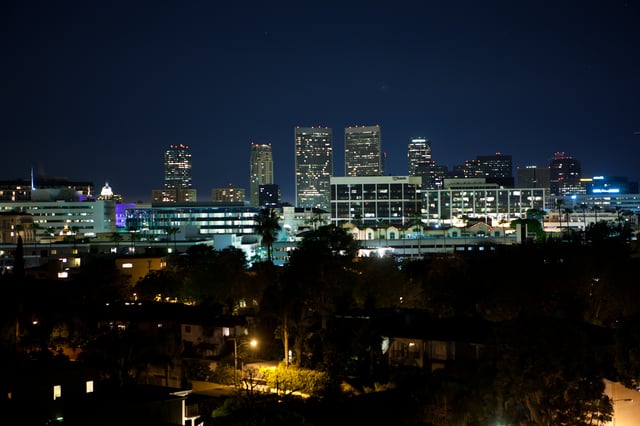
Downtown Beverly Hills at night with Century City in the distance, 2011
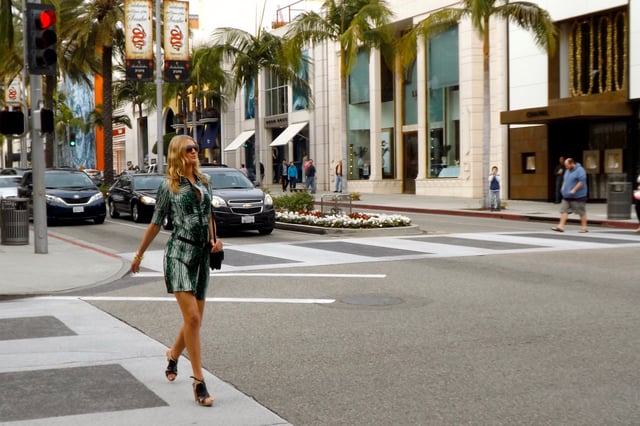
Model crosses Brighton Way at Rodeo Drive during a photo shoot, 2013.
In 2001, LACMTA then proposed a bus rapid transit route down Santa Monica Blvd., but this was also opposed by the city and never built. Currently this stretch of road is served by less efficient Metro Rapid buses using pre-existing roadways.[41] By 2010, traffic in Beverly Hills and surrounding areas had grown bad enough that the city's habitual opposition had largely turned to support for subways within the city limits.[42] As part of the Westside Subway Extension project, the Purple Line of the LA Metro Rail is planned to be extended through Beverly Hills, adding two underground stations at Wilshire/La Cienega and Wilshire/Rodeo by the 2020s.[43]
In the midst of the 2015 drought, Beverly Hills was found to be one of the biggest water consumers in all of California.[44] As a result, they were asked by the state to reduce their consumption by 36%, prompting many residents to replace their lawns with native plants.[44] Meanwhile, the city government replaced the grass in front of the City Hall with Mexican sage.[44]
In September 2015, the City of Beverly Hills signed an agreement with the State of Israel to work together on water use as well as "cybersecurity, public health, emergency services, disaster preparedness, public safety, counterterrorism and art and culture".[45]
In July 2016, the City of Beverly Hills received the Livability Award from the United States Conference of Mayors for its Ambassador Program, which takes care of the city's homeless population.[46]
In November 2016, the Beverly Hills City Council passed a resolution to condemn the decision made by the UNESCO to deny the Jewish history of Temple Mount and the Western Wall in Jerusalem, Israel.[49]
Geography
Beverly Hills and the neighboring city of West Hollywood are together entirely surrounded by the city of Los Angeles. Specifically, Beverly Hills is bordered on the northwest by the Los Angeles neighborhood of Bel-Air and the Santa Monica Mountains, on the east by West Hollywood, the Carthay neighborhood of Los Angeles, and the Fairfax District of Los Angeles, and on the south by the Beverlywood neighborhood of Los Angeles.[50] The area's "Platinum Triangle" is formed by the city of Beverly Hills and the Los Angeles neighborhoods of Bel Air and Holmby Hills.
In spite of the city's name, most residents live in the "flats" of Beverly Hills, which is a relatively flat land that slants towards the hills, and includes all of Beverly Hills itself. The houses situated in the hillside north of Sunset Boulevard have a much higher value than the average housing price for the rest of the city. Santa Monica Boulevard divides the "flats" into two areas, locally known as "North or South of the tracks," referring to the train tracks that were once used by the old Pacific Electric streetcar line that traversed Beverly Hills along Santa Monica Blvd. Houses south of Wilshire Boulevard have more urban square and rectangular lots, in general smaller than those to the north. There are also more apartment buildings south of Wilshire Boulevard than anywhere else in Beverly Hills, and the average house value south of Wilshire is the lowest in Beverly Hills. Nearly all businesses and government offices in Beverly Hills are located south of Santa Monica Boulevard. Two notable exceptions are the Beverly Hills Hotel and the Beverly Hilton Hotel. Just outside the city limits to the west lies the Los Angeles Country Club. Other locations commonly associated with Beverly Hills include the Cedars-Sinai Medical Center and the Beverly Center, just outside the city limits to the east.
Beverly Hills Post Office is an area of Los Angeles that the Beverly Hills Post Office serves and carries the "Beverly Hills, CA 90210" mailing address. The other four, less-celebrated ZIP codes for Beverly Hills are: 90209, 90211, 90212 and 90213.[9]
Climate
Beverly Hills has a warm Mediterranean climate, with an average high of 85 degrees Fahrenheit (29.4 degrees Celsius) in August, and an average high of 67 degrees Fahrenheit (19.5 degrees Celsius) in January (source Weather.com). Beverly Hills also receives an average 18 inches (460 mm) of rain per year. Summers are marked by warm to hot temperatures with very little wind, while winters are warm to moderate, with occasional rain alternating with periods of Santa Ana winds. Measurable snowfall has been recorded only in 1882, 1922, 1932, 1949 and 1958.
Demographics
2010
The 2010 United States Census[55] reported that Beverly Hills had a population of 34,109. The population density was 5,973.1 people per square mile (2,306.2/km²). The racial makeup of Beverly Hills was 28,112 (82.4%) White (78.6% Non-Hispanic White),[7] 746 (2.2%) African American, 48 (0.1%) Native American, 3,032 (8.9%) Asian, 12 (0.0%) Pacific Islander, 485 (1.4%) from other races, and 1,674 (4.9%) from two or more races. Hispanic or Latino of any race were 1,941 persons (5.7%).
The largest ethnic community are Persians, who make up over 26% of the population of Beverly Hills.[56]
The Census reported that 33,988 people (99.6% of the population) lived in households, 121 (0.4%) lived in non-institutionalized group quarters, and 0 (0%) were institutionalized.
There were 14,869 households, out of which 3,759 (25.3%) had children under the age of 18 living in them, 6,613 (44.5%) were opposite-sex married couples living together, 1,354 (9.1%) had a female householder with no husband present, 494 (3.3%) had a male householder with no wife present. There were 460 (3.1%) unmarried opposite-sex partnerships, and 131 (0.9%) same-sex married couples or partnerships. 5,400 households (36.3%) were made up of individuals and 1,834 (12.3%) had someone living alone who was 65 years of age or older. The average household size was 2.29. There were 8,461 families (56.9% of all households); the average family size was 3.05.
The population was spread out with 6,623 people (19.4%) under the age of 18, 2,526 people (7.4%) aged 18 to 24, 8,540 people (25.0%) aged 25 to 44, 9,904 people (29.0%) aged 45 to 64, and 6,516 people (19.1%) who were 65 years of age or older. The median age was 43.6 years. For every 100 females, there were 84.3 males. For every 100 females age 18 and over, there were 80.3 males.
There were 16,394 housing units at an average density of 2,870.9 per square mile (1,108.5/km²), of which 6,561 (44.1%) were owner-occupied, and 8,308 (55.9%) were occupied by renters. The homeowner vacancy rate was 2.2%; the rental vacancy rate was 8.0%. 17,740 people (52.0% of the population) lived in owner-occupied housing units and 16,248 people (47.6%) lived in rental housing units.
During 2009–2013, Beverly Hills had a median household income of $86,141, with 8.8% of the population living below the federal poverty line.[7]
2000
As of the census[57] of 2000, there were 33,784 people, 15,035 households, and 8,269 families residing in the city. The population density was 5,954.0 people per square mile (2,300.5/km²). There were 15,856 housing units at an average density of 2,794.4/mi (1,079.7/km²). The racial makeup of the city was 85.06% White, 1.77% African American, 0.13% Native American, 7.05% Asian, 0.03% Pacific Islander, 1.50% from other races, and 4.46% from two or more races. Hispanic or Latino of any race were 4.63% of the population.
There were 15,035 households out of which 24.4% had children under the age of 18 living with them, 43.8% were married couples living together, 8.1% had a female householder with no husband present, and 45.0% were non-families. 38.2% of all households were made up of individuals and 11.3% had someone living alone who was 65 years of age or older. The average household size was 2.24 and the average family size was 3.02.
In the city, the population was spread out with 20.0% under the age of 18, 6.3% from 18 to 24, 29.3% from 25 to 44, 26.8% from 45 to 64, and 17.6% who were 65 years of age or older. The median age was 41 years. For every 100 females, there were 83.5 males. For every 100 females age 18 and over, there were 79.4 males.
The median income for a household in the city was $70,945, and the median income for a family was $102,611. Males had a median income of $72,004 versus $46,217 for females. The per capita income for the city was $65,507. About 7.9% of families and 9.1% of the population were below the poverty line, including 9.5% of those under the age of 18 and 7.9% ages 65 or older.
Government
Municipal government
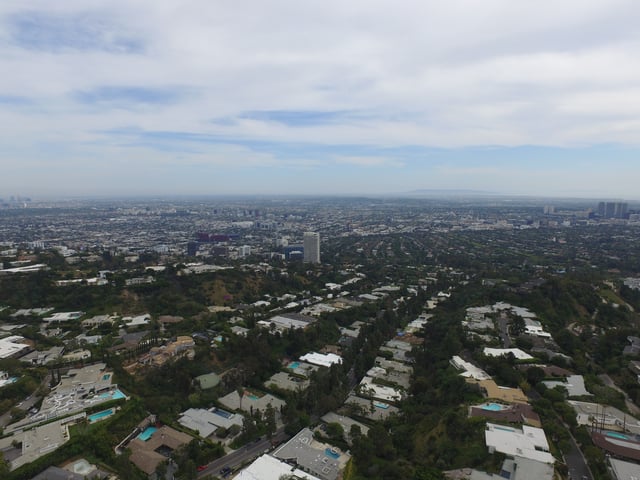
Trousdale Estates in Beverly Hills, CA
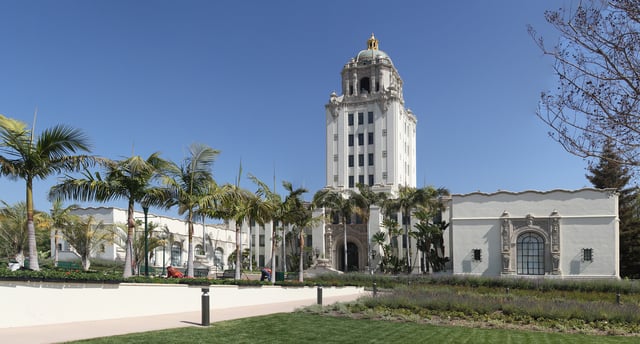
The Beverly Hills City Hall, built in 1931
Beverly Hills is a general law city governed by a five-member City Council including the mayor and vice mayor. The City Council hires a city manager to carry out policies and serve as executive officer. Until 2017, every odd-numbered year, either two or three members were elected for four-year terms. However, in 2017, the Council changed its cycle to conform with statewide elections; the first such election will be held in March 2020.[58] Each March the City Council meets and chooses one of its members as mayor and one as vice-mayor. As of 2018, Julian Gold is Mayor, John Mirisch is Vice Mayor, and Lester Friedman, Robert Wunderlich, and Lili Bosse are members.[2] Mahdi Aluzri serves as City Manager.[4]
County, state and federal representation
In the California State Legislature, Beverly Hills is in the 26th Senate District, represented by Democrat Ben Allen, and in the 50th Assembly District, represented by Democrat Richard Bloom.[59]
In the United States House of Representatives, Beverly Hills is in California's 33rd congressional district, represented by Democrat Ted Lieu.[60]
Infrastructure
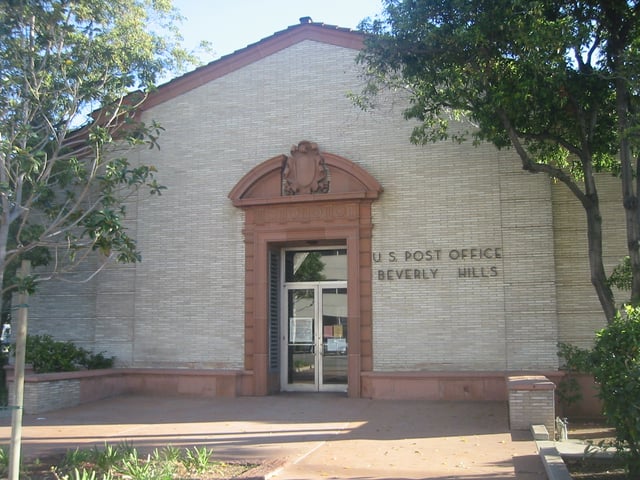
Former Beverly Hills Post Office
The Beverly Hills Police Department and the Beverly Hills Fire Department serve as emergency response for the city.
The United States Postal Service operates the Beverly Hills Post Office at 325 North Maple Drive,[63] the Crescent Post Office at 323 North Crescent Drive,[64] the Beverly Post Office at 312 South Beverly Drive,[65] and the Eastgate Post Office at 8383 Wilshire Boulevard.[66][67] The former Beverly Hills Post Office was listed on the National Register of Historic Places on January 11, 1985.[68]
Politics
The city of Beverly Hills widely opposed Proposition 8, the 2008 ballot measure which repealed legal recognition of same-sex marriages. The proposition narrowly passed statewide, but in Beverly Hills, only 34% voted in favor, and 66% voted against it.[69] In 2007, Jimmy Delshad became the city's first Iranian-born mayor, representing the city's large Iranian population.[70]
Economy
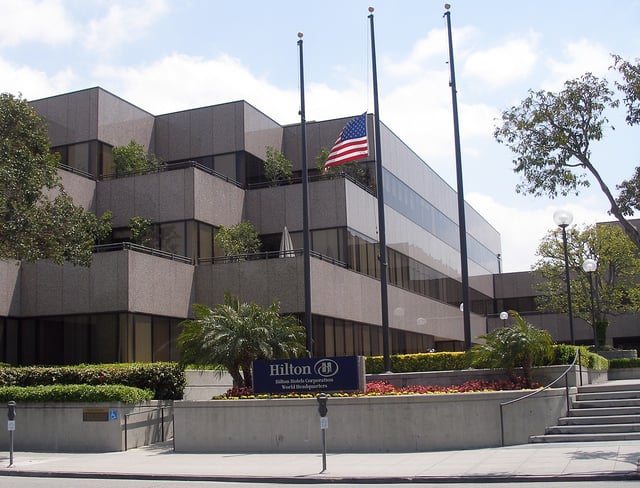
The former Hilton Hotels Corporation headquarters in Beverly Hills
Beverly Hills is home to one Fortune 500 company, Live Nation Entertainment. Since August 22, 2011, the headquarters of Metro-Goldwyn-Mayer have been located in Beverly Hills. The talent agencies United Talent Agency, William Morris Endeavor, Paradigm Talent Agency, The Gersh Agency, and Agency for the Performing Arts are based in Beverly Hills.
Hilton Hotels Corporation formerly had its corporate headquarters in Beverly Hills. The original headquarters of GeoCities (at first Beverly Hills Internet) was at 9401 Wilshire Boulevard in Beverly Hills.[71]
The large Beverly Hills Oil Field has four urban drilling islands, which drill diagonally into the earth underneath the city. One drilling islands occasioned a 2003 lawsuit representing former attendees of Beverly Hills High School, approximately 280 of which having suffered from cancers allegedly tied to the drilling operations.[72] The oil site on the high school grounds are in the process of being shut down.[73]
Top employers
According to the city's 2015 Comprehensive Annual Financial Report, the top employers in the city are:
| Employer | of Employees | |
|---|---|---|
| 1 | City of Beverly Hills | 1,042 |
| 2 | Beverly Hills Unified School District | 642 |
| 3 | Beverly Wilshire Hotel | 620 |
| 4 | The Beverly Hilton | 599 |
| 5 | The Beverly Hills Hotel | 500 |
| 6 | William Morris Agency | 500 |
| 7 | Saks Fifth Avenue | 460 |
| 8 | Neiman Marcus Group | 430 |
| 9 | Creative Artists Agency | 425 |
| 10 | The Peninsula Beverly Hills | 400 |
Education
Beverly Hills is served by Beverly Hills Unified School District, which includes 2 K-8 schools (Hawthorne and Horace Mann), one middle school (Beverly Vista), Moreno High School, and the Beverly Hills High School.
Beverly Hills also has several private schools. Good Shepherd School, a PreK-8 school in Beverly Hills, is a part of the Roman Catholic Archdiocese of Los Angeles. Other Beverly Hills private schools include Harkham Hillel Hebrew Academy.
Notable people
Desi Arnaz[74]
Desi Arnaz, Jr.[75]
Lucille Ball[74]
Lionel Barrymore[76]
Richard Barthelmess[77]
Wallace Beery[78]
Jack Benny[76]
Polly Bergen[76]
Floyd Mayweather[76]
Monte Blue[78]
Ward Bond[78]
Hobart Bosworth[79]
William Boyd[78]
Albert Brooks[80]
Johnny Mack Brown[78]
Winifred Bryson[81]
Stanley Chais[82]
Richard Chamberlain[83]
Rosemary Clooney[76]
Lew Cody[84]
Jackie Cooper[86]
Jeanne Crain[87]
Laird Cregar[78]
Robert Cummings[88]
Richard Dreyfuss[75]
Nelson Eddy
Hilda Eisen
Nanette Fabray
Douglas Fairbanks
Peter Falk[89]
José Ferrer
Herbert Flam [90]
Rhonda Fleming[91]
Mike Franks[92]
George Gershwin[93]
Ira Gershwin[94]
Burton E. Green[96]
Hank Greenberg[97]
EJ Johnson
Fritz Lang[98]
Logan Lerman[100]
Mervyn LeRoy[101]
Oscar Levant
Jack Linkletter[102]
Frank Lovejoy
Hal March
Kathy May
Vincente Minnelli[103]
Elizabeth Montgomery
Agnes Moorehead
Maureen O'Sullivan
Markus Persson[105]
Mary Pickford
André Previn[106]
Carl Reiner
Rob Reiner[75]
Lionel Richie[107]
Melissa Rivers[108]
Gilbert Roland
Barbara Rush
Judith Sheindlin[110]
Al Sherman
Richard M. Sherman[111]
Robert B. Sherman[112]
Phil Spector[113]
James Stewart[114]
Harry Styles[115]
Lisa Vanderpump[116]
Leroy H. Watson[117]
Betty White[75]
William Wyler[119]
City media
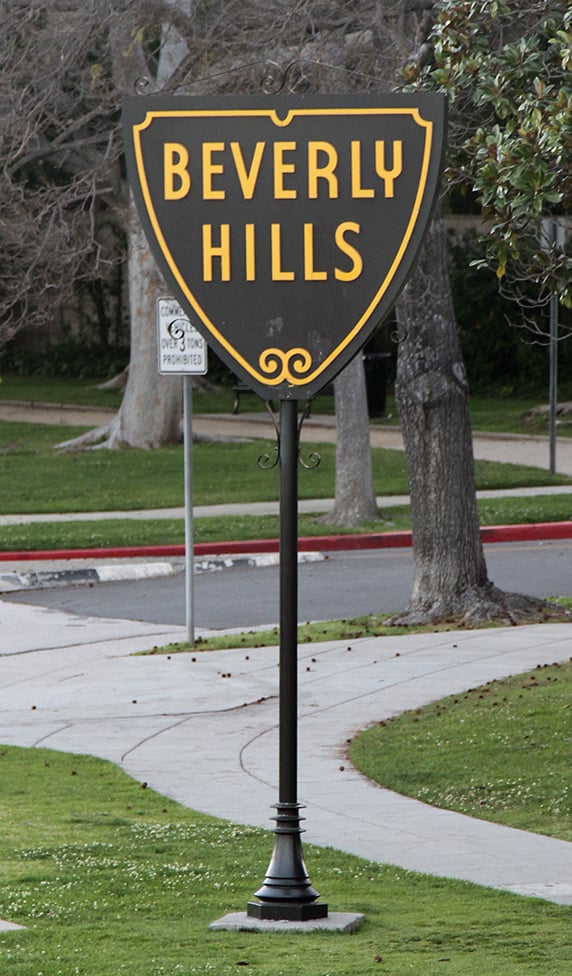
Sign marking the Beverly Hills city limits
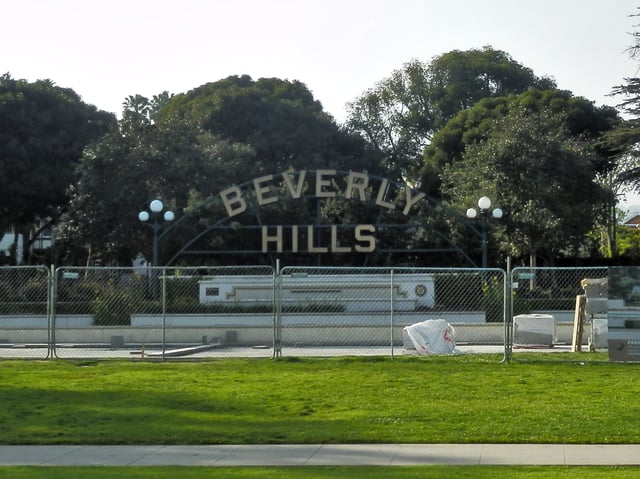
Beverly Hills Sign in Beverly Gardens Park
Beverly Hills is served by free weekly newspapers the Beverly Hills Courier and Beverly Hills Weekly.
The BHUSD has a public-access television station called KBEV, which is run by the students of Beverly Hills High School.[120] KBEV was founded in 1968. KBEV produces many programs, including the Norman News, which is the longest running student news service in the country.
Autonomous vehicles
In April 2016,[121] the Beverly Hills City Council passed a resolution[122] to create autonomous vehicles for public transportation within the next decade.[123] Mayor John Mirisch has said this is one of his top priorities during his tenure as mayor. "This is a game-changer for Beverly Hills and, we hope, for the region," said Mirisch in the press release. "Beverly Hills is the perfect community to take the lead to make this technology a reality. It is now both feasible and safe for autonomous cars to be on the road."[124]
Landmarks
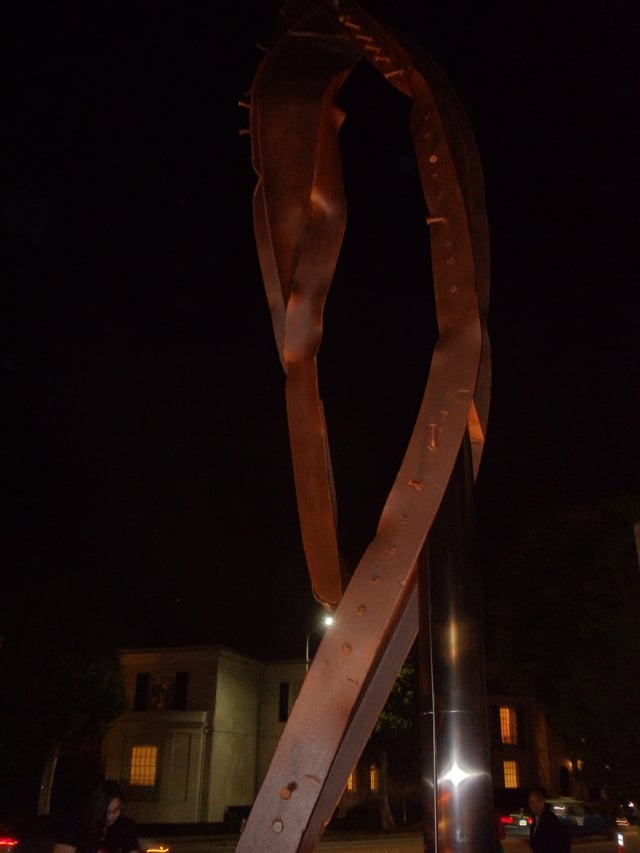
Monument at the Beverly Hills 9/11 Memorial Garden, Beverly Hills, California
Beverly Gardens Park
Beverly Hills 9/11 Memorial Garden
Beverly Hills City Hall
Beverly Hills Hotel
Beverly Hills Police Department
Beverly Hills Public Library
Beverly Hills Women's Club
Beverly Wilshire Hotel
Electric Fountain
Greystone Mansion
Greenacres
La Cienega Park
Misty Mountain
Pickfair
Rodeo Drive
Roxbury Memorial Park
Virginia Robinson Gardens
Will Rogers Memorial Park
In popular culture
The opening scene of The Andy Griffith Show (1960–1968), showing Sheriff Taylor and Opie carrying fishing poles, was shot at the Franklin Canyon Reservoir at the north end of town, just west of Coldwater Canyon.[125]
Notable neighborhoods
Trousdale Estates is a 410-acre neighborhood of large, luxurious homes in Beverly Hills. It was primarily developed in the 1950s and early 1960s by Paul Trousdale, who petitioned the city to incorporate the land into Beverly Hills soon after purchasing it from The Doheny Family.[127] Greystone Mansion, which is now designated as a United States Historical Site, is in Trousdale Estates.[128] The average sale price of homes in Trousdale is over $10 million.[129]
Sister cities
[[INLINE_IMAGE|//upload.wikimedia.org/wikipedia/commons/thumb/f/fc/Flag_of_Mexico.svg/23px-Flag_of_Mexico.svg.png|//upload.wikimedia.org/wikipedia/commons/thumb/f/fc/Flag_of_Mexico.svg/35px-Flag_of_Mexico.svg.png 1.5x, //upload.wikimedia.org/wikipedia/commons/thumb/f/fc/Flag_of_Mexico.svg/46px-Flag_of_Mexico.svg.png 2x|Mexico|h13|w23|thumbborder flagicon-img flagicon-img]] Acapulco, Mexico[130]
[[INLINE_IMAGE|//upload.wikimedia.org/wikipedia/en/thumb/c/c3/Flag_of_France.svg/23px-Flag_of_France.svg.png|//upload.wikimedia.org/wikipedia/en/thumb/c/c3/Flag_of_France.svg/35px-Flag_of_France.svg.png 1.5x, //upload.wikimedia.org/wikipedia/en/thumb/c/c3/Flag_of_France.svg/45px-Flag_of_France.svg.png 2x|France|h15|w23|thumbborder flagicon-img flagicon-img]] Cannes, France[130]
Herzliya, Israel[131]
Pudong, China[131]
See also
[[INLINE_IMAGE|//upload.wikimedia.org/wikipedia/commons/thumb/3/34/City_hall_model.jpg/220px-City_hall_model.jpg|//upload.wikimedia.org/wikipedia/commons/thumb/3/34/City_hall_model.jpg/330px-City_hall_model.jpg 1.5x, //upload.wikimedia.org/wikipedia/commons/3/34/City_hall_model.jpg 2x||h139|w220|thumbimage]] Early plans for City HallList of largest houses in the Los Angeles Metropolitan Area





